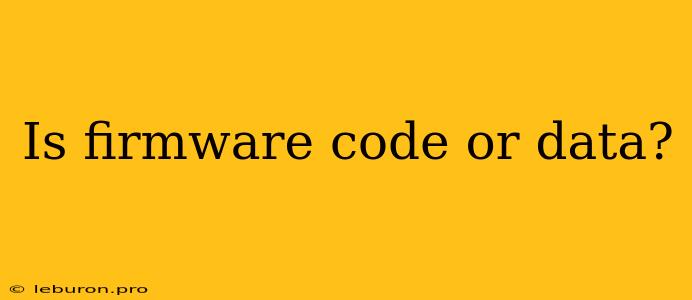Firmware is a type of software that is embedded into hardware devices to control their basic functions. It is often confused with software, but there are key differences between the two. This article will explore the question of whether firmware is code or data, analyzing its characteristics and comparing it to software. By understanding the nature of firmware, you will gain a better grasp of its role in the operation of various electronic devices.
Understanding Firmware
Firmware is a specialized type of software that is designed to provide low-level control over hardware. It acts as an intermediary between the hardware and the operating system, ensuring that the device functions correctly. Unlike traditional software, which is typically installed on a computer's hard drive, firmware is permanently stored in the device's memory.
Key Characteristics of Firmware:
- Embedded: It is embedded into the device's memory, typically a flash memory chip, and cannot be easily modified or removed.
- Low-Level Control: Firmware controls the basic functions of the device, such as booting up, managing I/O operations, and interacting with hardware components.
- Device-Specific: Firmware is designed for a specific hardware device and is often tailored to its unique capabilities and requirements.
- Limited User Interaction: Users typically do not directly interact with firmware. It operates behind the scenes, ensuring the device functions correctly.
Firmware vs. Software: A Comparative Analysis
While both firmware and software are forms of instructions, they differ significantly in their purpose, implementation, and interaction with hardware.
1. Purpose and Function
- Firmware: Provides low-level control of hardware components, ensuring the device's basic functionality.
- Software: Provides applications and tools for users to interact with the device and perform specific tasks.
2. Location and Modification
- Firmware: Stored in non-volatile memory (e.g., flash memory) within the device and typically requires specialized tools to update or modify.
- Software: Stored on a computer's hard drive or other storage devices and can be easily installed, uninstalled, or updated by the user.
3. Interaction with Hardware
- Firmware: Directly interacts with hardware components, controlling their functions and ensuring compatibility.
- Software: Interacts with hardware through the operating system or drivers, relying on the firmware for low-level control.
Firmware: Code or Data?
The question of whether firmware is code or data is a complex one. To understand this, we need to delve into the concept of executable code and data.
Executable Code vs. Data
- Executable Code: Instructions that the processor can execute directly. These instructions are typically stored in a program's memory and are responsible for carrying out the program's logic.
- Data: Information that is used by the program but is not directly executed by the processor. This includes variables, constants, and other data structures.
Firmware: A Combination of Code and Data
Firmware is essentially a combination of code and data. It contains the instructions that control the device's operation (code) and the data structures needed to configure and manage the hardware (data).
Code in Firmware:
- Bootloader: Responsible for initializing the device and loading the operating system.
- Device Drivers: Control the interaction between the hardware and the operating system.
- Control Logic: Defines how the device responds to various inputs and events.
Data in Firmware:
- Configuration Settings: Determines the device's operating parameters and user preferences.
- Look-Up Tables: Store pre-calculated data used for specific operations.
- Calibration Data: Used to adjust the device's performance based on its specific hardware characteristics.
The Importance of Firmware in Modern Technology
Firmware plays a crucial role in the operation of various electronic devices. From smartphones and laptops to cars and industrial equipment, firmware ensures that these devices function correctly and meet the needs of their users.
Applications of Firmware:
- Consumer Electronics: Smartphones, tablets, TVs, and other devices rely on firmware to manage their core functions.
- Computers: BIOS (Basic Input/Output System) is a type of firmware that controls the basic functions of a computer, including booting up and managing hardware resources.
- Automotive: Embedded systems in vehicles use firmware to manage engine control, braking systems, and other safety features.
- Industrial Automation: Industrial robots, control systems, and other equipment rely on firmware for precise operation and control.
Conclusion: Firmware - An Essential Component of Modern Technology
Firmware is a critical component of modern technology, acting as the bridge between hardware and software. While it is often considered a type of software, it is more accurately described as a combination of code and data that provides low-level control over the device's functionality.
Firmware is not simply data; it is a blend of code and data that defines the device's behavior and capabilities. Understanding the nature of firmware is crucial for comprehending the complexities of modern electronic devices and their interactions with both software and hardware. As technology continues to evolve, firmware will remain a vital element in ensuring the seamless operation of our digital world.
